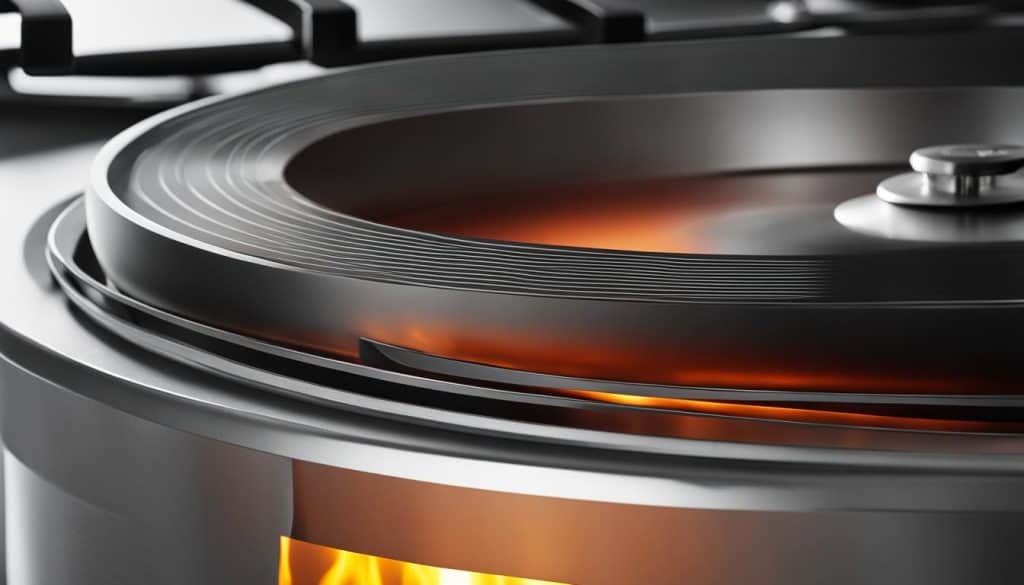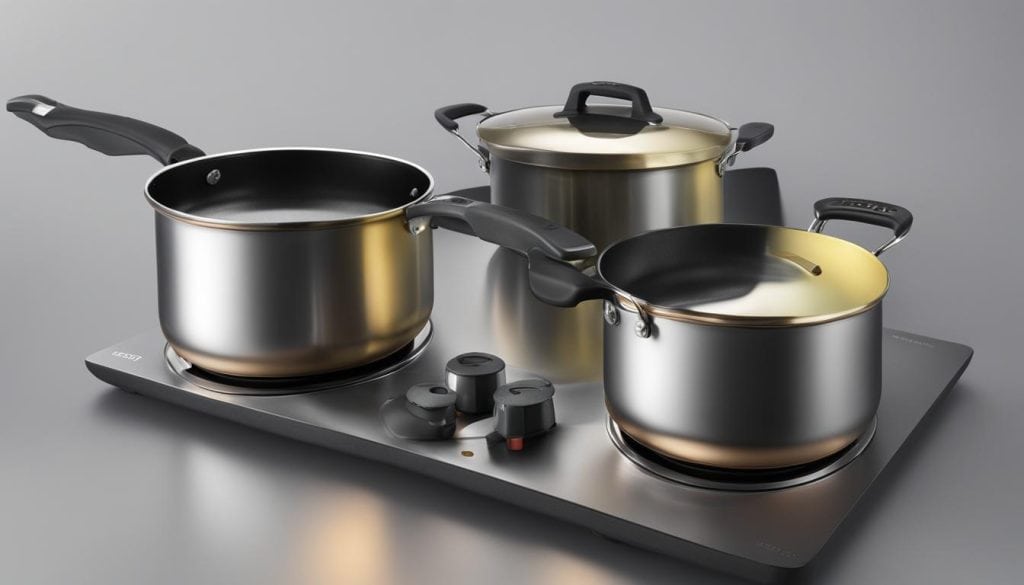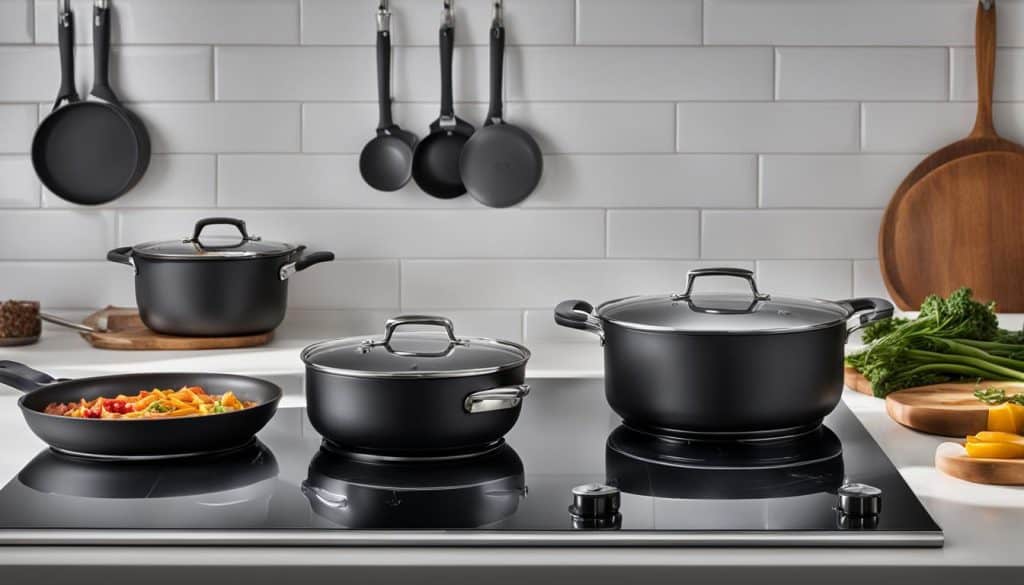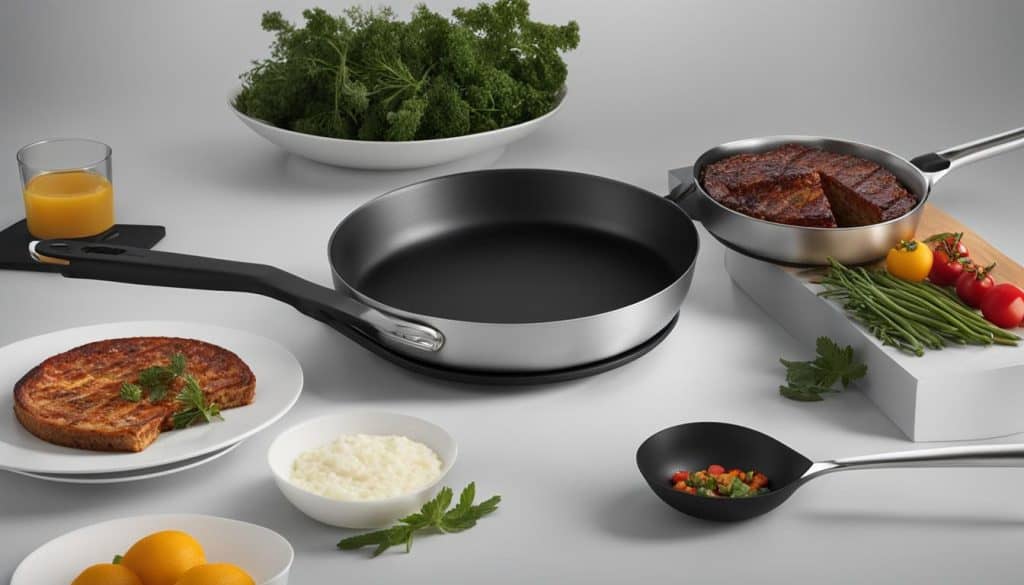Are you tired of unevenly cooked food? Do you crave faster cooking times without sacrificing quality? Look no further than cookware designed for fast and even heating.
One key feature to look for is a t ee-layer bottom, which ensures good thermal conductivity and consistent heat distribution t oughout the cooking process. This means your food will cook evenly from the bottom up, eliminating hot spots that can lead to burnt or undercooked sections.
Investing in cookware with good thermal conductivity and even heating can make all the difference in the quality of your meals. Say goodbye to unevenly cooked dishes and hello to perfectly cooked food every time.
< class="wp-block-separator has-alpha-channel-opacity"/>Factors to Consider when Choosing Cookware for Fast and Even Heating
When selecting cookware for fast and even heating, there are certain key factors to consider to make an informed decision. Below, we discuss the top ten factors that can influence your choice of cookware.
1. Layered Construction
Cookware with layered construction, such as the t ee-layer bottom, is critical for optimal heat distribution and even heating.
The base layer should have a good thickness to retain heat, while the core layer should have a high heat conductivity for efficient heat transfer. The top layer should be made of a durable material for long-lasting performance.
2. Heat Conductivity
The heat conductivity of the cookware material affects how quickly and evenly heat is transferred t oughout the cooking surface. Copper, for example, is an excellent heat conductor, while stainless steel is not. Cookware with high heat conductivity ensures that the food is cooked evenly and quickly.
3. Base Thickness
The base thickness of the cookware affects its heat distribution. A thicker base may provide better heat retention, but if too thick, it may take longer to heat up and distribute heat evenly. An optimal base thickness provides a balance between quick heating and even heat distribution.
4. Compatibility with Heat Sources
Check the compatibility of the cookware with the heat source you use for cooking. Some cookware is not suitable for use on induction stovetops, for example. Ensure you have the right cookware for your heat source to avoid any inconvenience or damage to the cookware.
5. Heat Retention
Cookware with good heat retention ensures that your food is kept warm for a long time after removing it from the heat. This is particularly important when serving food, as you want it to remain hot for as long as possible.
6. Reactivity to Temperature Changes
Certain materials react differently to temperature changes, especially when exposed to acidic or alkaline substances. For example, aluminum cookware may discolor when cooking acidic foods. Ensure that the cookware you choose is stable and resists damage when exposed to temperature changes in your cooking.
7. Flat Base
A flat base is essential for maximum contact with the heat source, ensuring that heat is distributed evenly. This helps to prevent hotspots and unevenly cooked food.
8. Durable Construction
The cookware should be made of durable materials that can withstand high heat and normal wear and tear. Choose cookware that is built to last for a long time and provides a good return on investment.
9. Energy Efficiency
Cookware that is energy-efficient, such as those with good heat conductivity and retention, helps to save energy and reduce cooking time. This not only saves you money on your energy bill, but it also reduces your carbon footprint.
10. Quality of Materials
The quality of the materials used in the construction of the cookware affects its performance and longevity. Choose cookware made of high-quality materials to ensure a consistent cooking experience and long-lasting performance.
Advantages of Cookware with Fast and Even Heating
Choosing cookware with fast and even heating offers several advantages that will enhance your cooking experience. Whether you are a professional chef or a home cook, these benefits will help you achieve delicious and consistent results every time you cook. Below are the key advantages of cookware with fast and even heating:
- Improved cooking results: Fast and even heating ensures that your food is cooked evenly, eliminating the risk of undercooked or overcooked dishes. This results in better texture, flavor, and overall quality of your food.
- Time efficiency: With evenly heated cookware, your food will cook faster, saving you valuable time in the kitchen. This is especially important when preparing meals with longer cooking times.
- Energy savings: Cookware with fast and even heating helps reduce energy consumption by requiring less heat and cooking time, resulting in lower utility bills.
- Versatile cooking: Cookware with fast and even heating allows you to cook a variety of dishes without worrying about hotspots or uneven cooking. This provides greater flexibility in your cooking options.
- Reduced hotspots: Hotspots can cause food to burn and stick to the cookware. Cookware with fast and even heating eliminates these hotspots, resulting in a more enjoyable cooking experience.
- Consistent performance: Cookware with fast and even heating ensures that your dishes will turn out the same way every time you cook them.
- Longevity: High-quality cookware with fast and even heating will last longer than their cheaper counterparts, reducing the need for frequent replacement.
- Professional cooking experience: Cookware with fast and even heating provides a professional cooking experience, allowing you to cook like a pro in your own kitchen.
- Cost-effective: Investing in high-quality cookware may cost more upfront, but it can save you money over time by reducing energy consumption and minimizing the need for frequent replacement.
- Enhanced safety: Cookware with fast and even heating reduces the risk of burns and other accidents in the kitchen, ensuring a safe and enjoyable cooking experience.

As you can see, choosing cookware with fast and even heating provides a range of benefits that will make your time in the kitchen more enjoyable and efficient. Keep these advantages in mind when selecting your next set of cookware.
< class="wp-block-separator has-alpha-channel-opacity"/>Understanding T ee-Layer Bottom Cookware
When it comes to cookware for fast and even heating, the design of the bottom is crucial to ensure consistent heat distribution.
The t ee-layer bottom is a popular choice for cookware due to its excellent heat conductivity and even heating. The layers typically consist of an aluminum or copper core sandwiched between two layers of stainless steel.
The construction of the t ee-layer bottom cookware allows for efficient heat distribution, reducing hotspots and ensuring that food is cooked evenly t oughout. The aluminum or copper core is an excellent heat conductor and is sandwiched between layers of stainless steel to ensure durability and easy maintenance.
The thermal conductivity of aluminum and copper allows for quick and even heat distribution, making them an ideal choice for the bottom layer of cookware. Stainless steel, on the other hand, is resistant to corrosion, ensuring longevity of the cookware.
The t ee-layer bottom construction also allows the cookware to be compatible with a variety of heat sources, including gas stoves, electric stoves, and induction stoves. The combination of materials ensures that the cookware can withstand high heat and maintain its shape, preventing warping or damage under extreme conditions.
If you’re looking for cookware that provides fast and even heating, a t ee-layer bottom cookware is an excellent investment. The construction, heat distribution, and thermal conductivity offer superior performance and a professional cooking experience.
< class="wp-block-separator has-alpha-channel-opacity"/>Choosing the Right Materials for Fast and Even Heating
When selecting cookware that offers fast and even heating, one of the most critical decisions you’ll need to make is the material of the pot or pan. The right material can ensure the efficient transfer of heat, resulting in perfectly cooked meals every time. Here are some of the most popular materials for fast and even heating:
| Material | Pros | Cons |
|---|---|---|
| Aluminum | Excellent heat conductor, lightweight, and affordable | Can react with acidic food, may warp at high heat |
| Copper | Superior heat conductivity, durable, and attractive | Expensive, requires maintenance, may react with acidic food |
| Stainless Steel | Durable, easy to clean, and non-reactive with food | Poor heat conductivity, may have hotspots |
| Cast Iron | Durable, retains heat well, and non-reactive with food | Heavy, slow to heat up, requires seasoning and ongoing maintenance |
Aluminum and copper are excellent choices for fast and even heating thanks to their superior heat conductivity, making them a popular choice for professional chefs.
However, aluminum can react with acidic foods, causing a metallic taste in your meals and warping at high heat. Copper is a premium option but requires maintenance to keep its shine and may react with acidic foods.
Stainless steel and cast iron are durable options that are non-reactive with food but have their limitations when it comes to heat conductivity and hotspots.
Ultimately, the material you choose will depend on your cooking needs and preferences. Consider the type of dishes you will be cooking and the heat source you will be using to make the best decision for your kitchen.

How Base Thickness Impacts Heat Distribution
When it comes to cookware for fast and even heating, base thickness plays a crucial role in determining the performance of your pots and pans. The thickness of the base affects how quickly the cookware heats up and how well it distributes heat.
A thicker base takes longer to heat up but distributes heat more evenly, while a thinner base heats up faster but may create hotspots that can lead to uneven cooking. Finding the right balance between quick heating and even heating can make all the difference between a perfect meal and a culinary disaster.
The optimal base thickness for cookware for fast and even heating typically ranges from 3mm to 5mm. This thickness ensures that the heat is distributed evenly t oughout the cookware, resulting in consistent cooking performance.
Quick Tip: Look for cookware with a heavy base that has a thick layer of aluminum or copper sandwiched between layers of stainless steel or other materials. This layered construction provides excellent heat distribution and retention, ensuring consistent and precise cooking.

How to Test Base Thickness
Not sure how thick your cookware base is? Here’s a quick and easy test:
- Fill your pan with water up to about 1 inch.
- Place the pan over medium heat on a stovetop burner.
- Using a cooking thermometer, monitor the temperature of the water.
- Observe the time it takes for the water to reach a rolling boil.
If the water reaches boiling point in less than t ee minutes, your cookware base is likely too thin for fast and even heating. If it takes more than five minutes to boil the water, your cookware base may be too thick and may not be suitable for quick heating.
Remember, choosing the right base thickness for your cookware is key to achieving consistent and precise cooking results.
< class="wp-block-separator has-alpha-channel-opacity"/>Cookware Compatibility with Different Heat Sources
When selecting cookware for fast and even heating, it’s essential to consider its compatibility with different heat sources. Your choice of heat source may vary according to your cooking methods and preferences, and this compatibility ensures that your cookware provides optimal performance.
Gas Stove: If you use a gas stove, consider cookware that has a flat bottom and a heavier weight to prevent tip-overs. Look for cookware with a thicker base that ensures even heat distribution, such as stainless steel and cast iron.
Electric Stove: Electric stoves have a flat and smooth heating surface that works well with all types of cookware. You can use any cookware made with materials suitable for fast and even heating, including aluminum, copper, cast iron, and stainless steel.
Induction Stove: Cookware designed for induction stoves must have a magnetic base, such as stainless steel or cast iron. Avoid cookware made of aluminum or copper, as they don’t have magnetic properties. Also, ensure the base of your cookware is even and flat to make consistent contact with the surface of the stove.
Before purchasing any cookware, make sure to check its compatibility with your heat source. If you have multiple heat sources, consider investing in cookware that is compatible with all of them. This way, you can use the same set of cookware for different cooking methods, ensuring a consistent and efficient cooking experience.

The Significance of Flat Base Cookware
When it comes to cooking, having cookware with a flat base is essential in achieving evenly cooked dishes. A flat base ensures maximum contact with the heat source, promoting uniform heating.
Whether you are using a gas stove, electric stove, or induction stove, having flat base cookware is crucial in ensuring a consistent cooking experience.
When you place a round-bottomed pot on a flat surface, it wobbles and doesn’t sit flush on the stove. This can lead to hot spots, creating unevenly cooked or burned food. Flat base cookware minimizes these hot spots and helps distribute heat evenly across the cooking surface.

The flat surface also ensures that you have maximum heat contact with the cooking surface. This enables your food to cook efficiently, reducing cooking time and energy use. In addition to promoting even heating, flat base cookware is also suitable for all kinds of cooking techniques, including sautéing, simmering, and searing.
Most modern cookware designs come with a flat base, making it easier to achieve consistent results when cooking. However, before making any purchases, ensure that the cookware has a flat base and that it is compatible with your preferred heat source.
< class="wp-block-separator has-alpha-channel-opacity"/>Durability and Safety Considerations for Cookware with Fast and Even Heating
When selecting cookware for fast and even heating, it’s crucial to consider durability and safety.
Your cookware needs to withstand the high heat required for optimal performance without warping or sustaining any damage. Additionally, you need to ensure safety during the cooking process, minimizing the risk of accidents or injuries.
Heat Resilience
Cookware that provides fast and even heating should be resilient to heat. The materials used in the construction of the cookware should have the capacity to withstand high temperatures without warping or losing their shape.
This is especially true for the base of the cookware, which is exposed to direct heat during cooking. The thickness of the base plays a huge role in maintaining the shape and integrity of the cookware.
Warping and Damage
Warping and damage are common problems that can arise when using cookware with fast and even heating. This can occur when the cookware is exposed to high temperatures or when it is not adequately cared for.
To avoid these issues, it’s essential to follow the manufacturer’s instructions for use and maintenance. Additionally, avoid sudden temperature changes, such as placing hot cookware in cold water, as this can cause warping and damage.
Heat Loss
Cookware that conducts heat quickly and evenly can also result in faster heat loss. This can be minimized by using cookware with a tight-fitting lid, which prevents heat from escaping and ensures that the food is cooked evenly.
You can also reduce heat loss by using cookware with a flat base, as this ensures maximum contact with the heat source, leading to uniform heating.
Safety Considerations
Safety is a critical consideration when using cookware with fast and even heating. Always use oven mitts or pot holders when handling hot cookware and avoid leaving cookware unattended on the stove.
Additionally, ensure that your cookware is compatible with your heat source, as mismatched cookware can cause accidents and injuries.
By considering durability and safety when selecting cookware with fast and even heating, you can enjoy the benefits of improved cooking results, time efficiency, energy savings, versatile cooking options, reduced hotspots, consistent performance, longevity of the cookware, professional cooking experience, cost-effectiveness, and enhanced safety.


